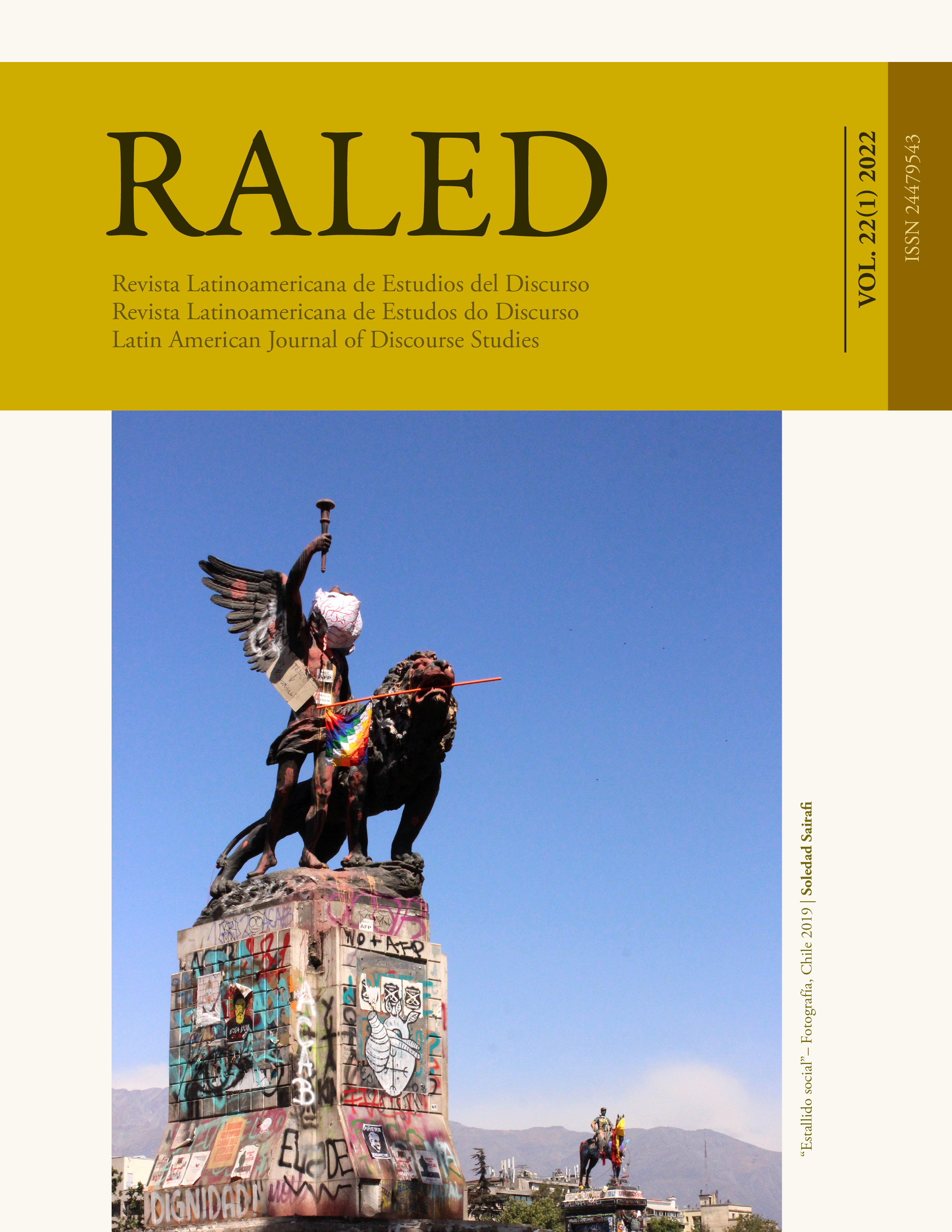La estrategia de elaboración de una sentencia y la construcción de estereotipos de mujer
DOI:
https://doi.org/10.35956/v.22.n1.2022.p.79-100Keywords:
STRATEGY, RESOURCE, JUDGMENT, FEMENINEAbstract
It is proposed to account for the different movements of a discursive strategy that we call “Elaboration of a judgment”, within the framework of three criminal judgments in which a differential evaluation of the behavior of men and women was carried out from a vision stereotyped of women to base the decision. Our proposal is part of the Strategic Discourse Analysis (AED) (Menéndez 2017, 2019) that takes systemic-functional linguistics as its base linguistic theory (Halliday 1978) and adopts a pragmatic, multimodal and critical perspective. It is based on the analysis of the relationships between grammatical and pragmatic resources that a discursive subject puts into operation when producing a text; Furthermore, it takes into consideration the contextual conditioning that is expressed in terms of register and discursive genre. The AED is relevant to justify how these sentences promote a disciplinary discourse on disapproved female subjectivities (Cusak 2014, Cardoso Onofre de Alencar 2015).
References
Agüero San Juan, C., Zambrano-Tiznado, J.P., Arena, F. y Coloma Correa, R. 2020. Análisis lingüístico y estereotipos en una sentencia penal chilena. Literatura y Lingüística 41: 237-262.
Amossy, R. y Herschberg Pierrot, A. [1997] 2015. Estereotipos y clichés. Buenos Aires: Eudeba.
Arenas, F. 2016. Los estereotipos normativos en la decisión judicial. Una exploración conceptual. Revista de Derecho 29, 1: 51-75.
Austin, J.L. 1963. How to things with words. Cambridge: Harvard University Press.
Bajtín, M. [1944] 2008. El problema de los géneros discursivos. En Estética de la creación verbal, pp. 245-290. México: Siglo XXI.
Cardoso Onofre de Alencar, E. 2015. [Disponible en línea https://e-revistas.uc3m.es/index.php/EUNOM/article/view/2801]. Mujeres y estereotipos de género en la jurisprudencia de la Corte Interamericana de Derechos Humanos. Eunomía. Revista en Cultura de la Legalidad 9: 26-48 [Consulta: 23 de julio de 2021].
Cucatto, M. 2009. La conexión en las sentencias penales de primera instancia. Del análisis de textos a la práctica de escritura de sentencias. Revista de Llengua i Dret 51: 135-160.
Cusack, S. 2014. [Disponible en línea http//www.ohchr.org/Documents/Issues/Women/WRGS/judicialstereotyping 2014.dox]. Eliminating Judicial Stereotyping: Equal Access to Justice for Women in Gender-based Violence Cases. Submited to the Office of the High Commissioner for Human Rights [Consulta: 24 de julio de 2021].
Eggins, S. 2004. An Introduction to Systemic Functional Linguistics. New York & London: Continuum.
Fletcher, G.P. [2007] 2008. Gramática del Derecho Penal. Buenos Aires: Hammurabi.
Grice, H.P. 1989. Studies in the Ways of Words. Harvard: Harvard University Press.
Halliday, M.A.K. 1970. Language structure and language function. En J. Lyons (Ed.). New Horizons of Linguistics, pp. 140-164. Harmondsworth, UK: Penguin
Halliday, M.A.K. 1973. Explorations in the functions of language. London: E. Arnold.
Halliday, M.A.K. 1978. Language as Social Semiotics. London: E. Arnold.
Halliday, M.A.K. 1985. Introduction to functional grammar. London: E. Arnold.
Halliday, M.A.K. y Hasan, R. [1976] 1994. Cohesion in English. London & New York: Longman.
Halliday, M.A.K. y Mathiessen, CH. [1985] 2014. Halliday´s Introduction to Functional Grammar. Fourth Edition. London: E. Arnold.
Martin, J. 1990. English Text. Amsterdam: Benjamins.
Menéndez, S. M. 1997. Hacia una teoría del contexto discursivo. Tesis doctoral. Facultad de Filosofía y Letras, Universidad de Buenos Aires. Inédita.
Menéndez, S. M. 2000. Estrategias discursivas: Principio metodológico para el análisis pragmático del discurso. En J.J. de Bustos y P. Chareadeau (Eds). Lengua, discurso, texto (I Simposio Internacional de Análisis del discurso), pp. 926-945. Madrid: Visor.
Menéndez, S.M. 2005. Gramática, análisis del discurso e interpretación crítica: las relaciones no tan evidentes. Proceeding of the International Conference on Critical Discourse Analysis. Valencia: Universitat de Valencia. Edición en CD.
Menéndez, S. M. 2010. Opción, registro y contexto. El concepto de significado en la lingüística sistémico-funcional. Tópicos del seminario 23, 1: 221-240.
Menéndez, S.M. 2012. Multimodalidad y estrategias discursivas: un abordaje metodológico. Revista Latinoamericana De Estudios Del Discurso 12, 1: 57-73.
Menéndez, S.M. 2013. La clasificación de los verbos en español: El principio de gradualidad. Un enfoque sistémico-funcional. En L. Funes (Ed.). XVII Actas del Congreso de la Asociación Internacional de Hispanistas, pp. 253-269. Buenos Aires: Facultad de Filosofía y Letras.
Menéndez, S.M. 2017. De la opción al recurso: de la gramática al registro. En E. Ghio, F. Navarro y A. Lukin (Comps.). Halliday, M.A.K. Obras esenciales, pp. 17-34. Buenos Aires/Santa Fe: Eudeba /Universidad Nacional del Litoral.
Menéndez, S.M. 2019. Entre la gramática y el género: el discurso. Un enfoque estratégico. En O.I. Londoño Zapata (Ed.). Los intersticios del análisis del discurso en Argentina, pp.115-132. Bogotá: Universidad de Tolima.
Menéndez, S.M. 2021. Agentividad y discurso. La proyección discursiva de los procesos. Revista Signos. Estudios de Lingüística 54, 105: 214-235.
Real Academia Española/ Asociación de Academias de la Lengua Española. 2010. Nueva Gramática de la Lengua Española (NGLE). Manual. Argentina: Espasa.
Sperber, D. y Wilson, D. 1995. Relevance. Communication and Cognition. Harvard: Harvard University Press.
Taranilla, R. 2012. La justicia narrante. Un estudio sobre el discurso de los hechos en el proceso penal. Pamplona: Thomson Reuters. Aranzadi.
Verschueren, J. 1999. Understanding pragmatics. London: E. Arnold.
Downloads
Published
Issue
Section
License
Copyright (c) 2022 Leonel Fernando Vazquez Neira, Salvio Martín Menéndez

This work is licensed under a Creative Commons Attribution-NonCommercial-NoDerivatives 4.0 International License.
The authors retain the copyright and guarantee RALED the right to be the first publication of the work as well as a Creative Commons Attribution License that allows others to share the work with recognition of authorship and the initial publication in this journal.







